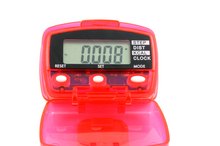What does fact checked mean?
At Healthfully, we strive to deliver objective content that is accurate and up-to-date. Our team periodically reviews articles in order to ensure content quality. The sources cited below consist of evidence from peer-reviewed journals, prominent medical organizations, academic associations, and government data.
- ACE: Calculate Your Calories Burned
- Harvard Medical School: Calories Burned in 30 Minutes for People of Three Different Weights
The information contained on this site is for informational purposes only, and should not be used as a substitute for the advice of a professional health care provider. Please check with the appropriate physician regarding health questions and concerns. Although we strive to deliver accurate and up-to-date information, no guarantee to that effect is made.
How to Burn 5,000 Calories Per Day
Resting Metabolic Rate Bonus
Calories provide the energy for your body to function so you are burning some every moment you are alive 1. That's called your resting metabolic rate and you can subtract your RMR from a daily goal of 5,000 calories for a nano-second blast of feel-good endorphins 1. Then you'll have the calorie balance -- dose of reality -- to deal with.
Short Method for Calculating RMR: Add a zero to your weight. This is roughly the amount of calories required to maintain life with no extra activity. Now work out your actual estimated calorie burn based on activity level: Sedentary - add 20 to 30 percent of your RMR to your RMR. Moderate Mover - add 50 percent of your RMR if you are active all day. Heavy Activity - add 60 to 80 percent of your RMR if you work construction, drive a pedicab, paint houses or install landscaping.
Your totals tell you the real difference between your normal day and a 5,000 calorie-burn day.
- Calories provide the energy for your body to function so you are burning some every moment you are alive 1.
- Now work out your actual estimated calorie burn based on activity level: Sedentary - add 20 to 30 percent of your RMR to your RMR.
Go Long and Strong
Short bursts of activity aren't going to cut it. You'll have to select intense activities that you can sustain for at least 30 minutes at a time, and longer is better. And remember, the more you weigh, the higher your RMR and the more calories it takes to move those pounds through an activity 1. Bantam weights have the disadvantage in this quest, although they likely have lower weight loss goals. Some activities that eat calories are: high-impact aerobics, stationary cycling and elliptical trainers at the gym; handball, martial arts, race-pace running, water polo and beach volleyball for after-hours and weekend meets and competitive games; snow shoveling, wood chopping, manual lawn mowing and grooming horses as necessary chores. Mix and match to fit enough movement into one day to meet calorie expenditure goals.
- Short bursts of activity aren't going to cut it.
- You'll have to select intense activities that you can sustain for at least 30 minutes at a time, and longer is better.
Extremes and Balances
If your goal is to reach a healthier weight, trim unsightly pounds and get seriously fit, burning 5,000 calories a day as a short-term strategy may provide the launch you need 1. But that's a tough schedule to maintain, unless you are training full time for the Olympics -- and it's too one-sided an approach to get you really healthy.
Ease off after your spectacular take-off with a smart combo of a nutritious, low-calorie diet and an intensified but realistic exercise regime. Build muscle, which burns more calories than fat even when you are resting. Schedule recovery times to avoid injuries that could sideline you so you're burning fewer calories.
Every 3,500 calories is worth a pound, however you lose it. Decrease your daily intake by 500 calories and you can lose a pound a week 1. Increase your activity level with an expenditure of an additional 500 calories a day and that's another pound 1. Balance is a beautiful thing.
- If your goal is to reach a healthier weight, trim unsightly pounds and get seriously fit, burning 5,000 calories a day as a short-term strategy may provide the launch you need 1.
Full Immersion
A big goal comes at a high cost -- in calories. Consider an extreme adventure weekend or signing up for a triathlon to boost your motivation for high-calorie burn. The 5,000 a day objective is a fairly macho approach, so be sure to check in with your healthcare provider to get the all-clear for your plan.
Triathlons combine cycling, swimming and running for a grueling test of fitness and speed. Harvard University assigns half-hour calorie deficits for these activities based on body weight. Cycling at 16 to 19 mph will cost you 360 calories at 125 pounds and 533 calories at 185 pounds. Swimming vigorous laps uses 300 calories and 444 calories, respectively. Running a 6-minute mile eats up 495 to 733 calories each half-hour based on your weight 1. Sustaining that level of intensity for hours is not realistic; calorie count decreases right along with speed and effort expended.
Weekend warriors weighing 150 pounds on extreme adventures might expend 544 calories per hour rock climbing, 612 calories per hour cross-country skiing and 500 to 600 calories per hour SCUBA diving. The more fun you are having, the less like work it seems.
- A big goal comes at a high cost -- in calories.
- Harvard University assigns half-hour calorie deficits for these activities based on body weight.
Related Articles
References
- ACE: Calculate Your Calories Burned
- Harvard Medical School: Calories Burned in 30 Minutes for People of Three Different Weights
- Jakici, John M., et al. Effect of Exercise on 24-Month Weight Loss Maintenance in Overweight Women. Arch Intern Med. 2008;168(14):1550-1559.
- Jakicic, John M., et al. "Appropriate Intervention Strategies for Weight Loss and Prevention of Weight Regain for Adults." ACSM Position Stand. Medicine & Science in Sports & Exercise, 2001.
- LaForge, Ralph. "Exercise Determinants of Weight Loss." ACE Certified News, Aug/Sept 2006, 3-6.
Writer Bio
Benna Crawford has been a journalist and New York-based writer since 1997. Her work has appeared in USA Today, the San Francisco Chronicle, The New York Times, and in professional journals and trade publications. Crawford has a degree in theater, is a certified Prana Yoga instructor, and writes about fitness, performing and decorative arts, culture, sports, business and education .









